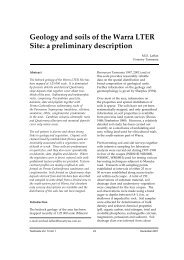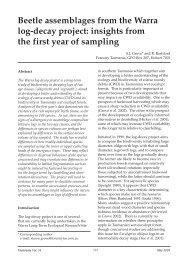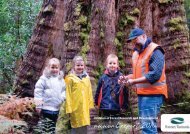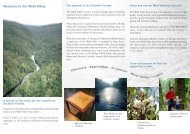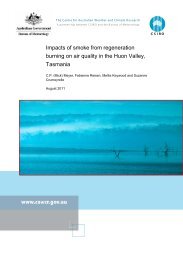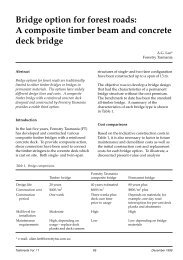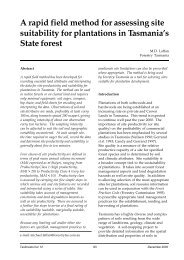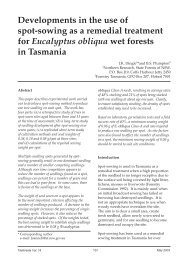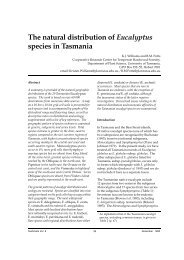sustainable forest management - Forestry Tasmania
sustainable forest management - Forestry Tasmania
sustainable forest management - Forestry Tasmania
You also want an ePaper? Increase the reach of your titles
YUMPU automatically turns print PDFs into web optimized ePapers that Google loves.
International science panel<br />
In addition to the knowledge and science gained from the<br />
Old Forests, New Management Conference, the <strong>Forestry</strong><br />
<strong>Tasmania</strong> Board engaged a five-member international<br />
science panel to provide advice on <strong>Forestry</strong> <strong>Tasmania</strong>’s<br />
program of reduced reliance on clearfelling in oldgrowth<br />
<strong>forest</strong>s.<br />
This panel included Mr Bill Beese (Canada); Mr Jack<br />
Bradshaw (Australia); Professor Jürgen Bauhus (Germany);<br />
Professor Tom Spies (USA) and Professor Ivan Tomaselli<br />
(Brazil). All panel members visited <strong>Forestry</strong> <strong>Tasmania</strong><br />
between July and September 2007 and prepared<br />
independent reports.<br />
Panel members were supportive of <strong>Forestry</strong> <strong>Tasmania</strong>’s<br />
program to reduce clearfelling of oldgrowth by adopting<br />
mixed silviculture, particularly variable retention.<br />
Professor Jürgen Bauhus commended <strong>Forestry</strong> <strong>Tasmania</strong>’s<br />
efforts to operationalise the variable retention system by<br />
developing innovative approaches to design of harvesting<br />
areas and regeneration burning. He noted that the main<br />
research need was to demonstrate the ecological benefits<br />
of the new system over clearfelling at the landscape, as well<br />
as the production unit scale.<br />
Mr Bill Beese noted that <strong>Tasmania</strong> had a world class strategy<br />
for biodiversity conservation. He considered the 80 per<br />
cent non-clearfell target to be appropriate and that it was<br />
useful to retain clearfelling of oldgrowth for some difficult<br />
sites. Conversely he noted that variable retention could be<br />
considered for regrowth in landscapes where there is very<br />
little oldgrowth, to retain or develop older <strong>forest</strong> elements.<br />
Mr Jack Bradshaw noted that much progress had been<br />
made towards implementing variable retention in both a<br />
research and operational sense. The greatest uncertainty<br />
lies in routine achievement of an operational regenerationburning<br />
program. This uncertainty could be clarified<br />
by another two years of operational experience and<br />
development.<br />
Professor Tom Spies reported that variable retention made<br />
ecological sense in <strong>Tasmania</strong>’s tall old growth eucalypt<br />
<strong>forest</strong>s and should retain elements of old <strong>forest</strong> biodiversity<br />
when compared to clearfelling. He urged greater emphasis<br />
on developing biodiversity goals at the landscape level<br />
(eg. how many hollow-bearing trees should be retained<br />
at the landscape level). He recommended that <strong>Forestry</strong><br />
<strong>Tasmania</strong> more clearly prioritise its economic, social and<br />
environmental goals and conduct landscape analysis across<br />
all land tenures to help place state <strong>forest</strong>s in a continuum of<br />
<strong>forest</strong> <strong>management</strong> goals. He observed that at a state level,<br />
<strong>Tasmania</strong> did not appear to have clear goals to maintain<br />
oldgrowth eucalypt <strong>forest</strong>s in reserves (or a mechanism to<br />
achieve this).<br />
Professor Ivan Tomaselli noted that <strong>Forestry</strong> <strong>Tasmania</strong>’s<br />
program to reduce clearfelling would allow it to continue<br />
harvesting oldgrowth <strong>forest</strong>s but that costs of doing<br />
so would increase over time. He recommended that<br />
the research program should continue, along with a<br />
communication strategy that focussed more on gains rather<br />
than problems and impacts. He recommended feasibility<br />
studies on increased removals from harvested old growth<br />
coupes to provide biomass energy and offset costs. He also<br />
believed that shorter rotations for eucalypt regrowth <strong>forest</strong>s<br />
should be explored to increase productivity.<br />
Left to right; Professor Jürgen Bauhus ; Professor Tom Spies;<br />
Professor Ivan Tomaselli; Mr Jack Bradshaw ; Mr Bill Beese.<br />
17




